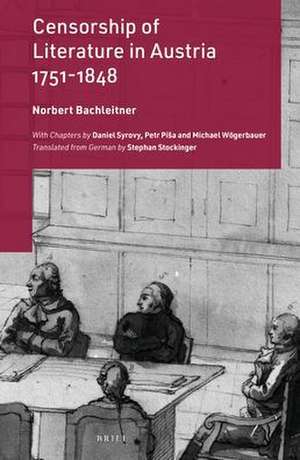Censorship of Literature in Austria, 1751-1848
Autor Norbert Bachleitneren Limba Engleză Hardback – 29 iun 2022
Preț: 654.91 lei
Preț vechi: 798.66 lei
-18% Nou
Puncte Express: 982
Preț estimativ în valută:
125.34€ • 130.51$ • 105.92£
125.34€ • 130.51$ • 105.92£
Carte indisponibilă temporar
Doresc să fiu notificat când acest titlu va fi disponibil:
Se trimite...
Preluare comenzi: 021 569.72.76
Specificații
ISBN-13: 9789004519275
ISBN-10: 9004519270
Dimensiuni: 155 x 235 mm
Greutate: 0 kg
Editura: Brill
Colecția Brill
ISBN-10: 9004519270
Dimensiuni: 155 x 235 mm
Greutate: 0 kg
Editura: Brill
Colecția Brill
Notă biografică
Norbert Bachleitner is a Professor emeritus of Comparative Literature at the University of Vienna, Austria. He was visiting professor at various universities including the Sorbonne nouvelle in Paris and is a member of the Academia Europaea. His fields of interest include the reception of English and French literature in the German speaking area; literary translation and transfer studies; social history of literature; censorship; literature in periodicals; intertextuality, and digital literature. His most recent book publications are (ed., together with Achim Hölter and John A. McCarthy) Taking Stock – Twenty-Five Years of Comparative Literary Research (Leiden, Boston: Brill 2020); (ed.) Literary Translation, Reception, and Transfer (Proceedings of the ICLA Conference in Vienna 2016, vol. 2, Berlin, Boston: De Gruyter 2020); and (ed., together with Juliane Werner) Popular Music and the Poetics of Self in Contemporary Fiction (Leiden, Boston: Brill 2022).
Cuprins
Author’s Foreword
List of Illustrations
1 Introduction
1On the Theory of Censorship Research: “Old” or “New” Censorship?
2The Historical-Sociological Definition of Censorship: Exercise of Political Power versus the Autonomy of Literature
3Modalities of Censorship over Time
4How Dangerous Is Literature?
2 In the Service of the Enlightenment: Censorship between 1751 and 1791
1What Went Before: Censorship in the Early Modern Period
2The Censorship Commission under Maria Theresa
3The Josephinian-Leopoldinian Era
4Commented Statistics of Prohibition Activity between 1754 and 1791
3 Censorship as an Instrument of Repression: The Era of Napoleon and the Vormärz Period (1792–1848)
1Between the French Revolution and Student Unrest: Censorship from 1792 to 1820
2Censorship in the Pre-march Period (1821–1848)
3Commented Statistics of Prohibition Activity between 1792 and 1848
4 A Look at the Crown Lands
1The Kingdom of Bohemia (1750–1848) (by Petr Píša and Michael Wögerbauer)
2The Italian-Speaking Territories of the Habsburg Monarchy (1768–1848) (by Daniel Syrovy)
5 The Censorship of Theater
1Theater Censorship in the Name of the Enlightenment under Maria Theresa and Joseph II (1770–1790)
2Theater Censorship under Francis II/I and Ferdinand I (1792–1848)
6 Case Studies
1Periodicals
2Chroniques scandaleuses
3The Theme of Suicide in Forbidden Literature
4The Period of Weimar Classicism
5The Romanticists
6The Historical Novel
7English Plays
8French Drama of the July Monarchy
7 Outlook
Appendix
Bibliography
Index of Named Persons
Index of Publishers and Booksellers
Index of Periodicals
List of Illustrations
1 Introduction
1On the Theory of Censorship Research: “Old” or “New” Censorship?
2The Historical-Sociological Definition of Censorship: Exercise of Political Power versus the Autonomy of Literature
3Modalities of Censorship over Time
4How Dangerous Is Literature?
2 In the Service of the Enlightenment: Censorship between 1751 and 1791
1What Went Before: Censorship in the Early Modern Period
2The Censorship Commission under Maria Theresa
3The Josephinian-Leopoldinian Era
4Commented Statistics of Prohibition Activity between 1754 and 1791
3 Censorship as an Instrument of Repression: The Era of Napoleon and the Vormärz Period (1792–1848)
1Between the French Revolution and Student Unrest: Censorship from 1792 to 1820
2Censorship in the Pre-march Period (1821–1848)
3Commented Statistics of Prohibition Activity between 1792 and 1848
4 A Look at the Crown Lands
1The Kingdom of Bohemia (1750–1848) (by Petr Píša and Michael Wögerbauer)
2The Italian-Speaking Territories of the Habsburg Monarchy (1768–1848) (by Daniel Syrovy)
5 The Censorship of Theater
1Theater Censorship in the Name of the Enlightenment under Maria Theresa and Joseph II (1770–1790)
2Theater Censorship under Francis II/I and Ferdinand I (1792–1848)
6 Case Studies
1Periodicals
2Chroniques scandaleuses
3The Theme of Suicide in Forbidden Literature
4The Period of Weimar Classicism
5The Romanticists
6The Historical Novel
7English Plays
8French Drama of the July Monarchy
7 Outlook
Appendix
Bibliography
Index of Named Persons
Index of Publishers and Booksellers
Index of Periodicals
